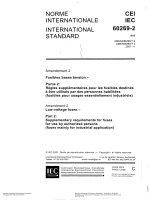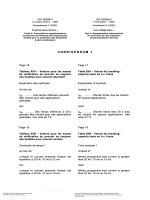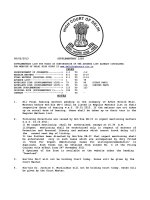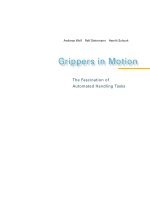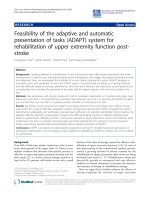Supplementary tasks pointers
Bạn đang xem bản rút gọn của tài liệu. Xem và tải ngay bản đầy đủ của tài liệu tại đây (348.85 KB, 7 trang )
Chapter 8: Pointers
A. Review
A.1. What is a pointer? Give at least three examples of pointers of different data types.
A.2. Differentiate the following expressions when variable is a pointer and when not by determining
which expressions are valid and which not, which expressions return a pointer and which not: &variable,
*variable, **variable, &*variable, *&variable.
A.3. What are differences between a fixed-size array of integer numbers and an array of integer
numbers controlled via a pointer?
int a[5] = {1, 2, 3, 4, 5};
int* aPtr = (int *)malloc(5*sizeof(int));
int i;
for (i=0; i<5; i++) aPtr[i] = a[i];
A.4. What are advantages and disadvantages of using an array located in heap memory as compared to
the one in stack memory? Give examples for illustration.
A.5. How can we refer to each member of a structure via a pointer which points to that structure? Give
an example for illustration.
A.6. Discuss address passing to pointers which are formal parameters of a function. Give an example for
illustration of each way of address passing.
A.7. What are dangling references? How to handle those dangling references? Give an example for
illustration.
A.8. What is a function pointer? Describe its use context via an example.
B. Practice
B.1. Re-define the arrays in the previous chapter, chapter 7, so that we have their equivalent arrays
located in heap memory.
B.2. Define pointers appropriate for the following descriptions.
B.2.1. A pointer that points to a character memory location
B.2.2. A pointer that points to a floating-point memory location
B.2.3. A pointer that points to a memory location of ten integer numbers
1
B.2.4. A pointer to a string that is located in the heap memory
B.2.5. A pointer to an array of strings that are located in the heap memory
B.2.6. A pointer to a matrix of floating-point numbers that are located in the heap memory
B.2.7. A pointer to an array of elements each of which is a structure of suppliers with two members: id
and value in the heap memory
B.2.8. A pointer to a list of functions to calculate a sum of the N first natural numbers and a factorial of a
natural number N
B.3. Find and fix the following program for no errors and memory leaks. What will be displayed on
screen?
2
B.4. Describe the value of each variable after each statement in the following program.
3
B.5. Given an array of n integer numbers with n input from a user, write a function to generate the
elements of this array randomly. After that, write a function to change the value of each element in the
array to a sum of its current value and the new value of the previous element and then write another
function to restore the array to its original version. Write a program to illustrate the sum-based
encoding of an array and its corresponding de-coding.
Input: n = 7
Output:
A random array is: 1, 2, 3, 4, 5, 6, 7
Sum-based encoding of this array: 1, 3, 6, 10, 15, 21, 28
Its corresponding de-coding: 1, 2, 3, 4, 5, 6, 7
B.6. Write a program to check if a matrix is a diagonal matrix, a lower triangular matrix, or an upper
triangular matrix. If not, change it to a corresponding diagonal, lower triangular, or upper triangular
matrix. A diagonal matrix is a square matrix with all elements outside the main diagonal equal to zero. A
lower triangular matrix is a square matrix with all elements above the main diagonal equal to zero. An
4
upper triangular matrix is a square matrix with all elements below the main diagonal equal to zero. It is
noted that the size of a matrix is not given in advance.
B.7. Given the information of each food item as displayed in the following table:
(Source: A multiple regression project, Roger Johnson.)
Define a structure to represent each food item. Among these food items, which one has the smallest
standard deviation: calories, fat, protein, or carbohydrates?
B.8. Given an array of n integer numbers and another integer number num, complete the following
function to return all the addresses of the elements in the array that are equal to the given number
num. After that, write a program to illustrate a function call with the resulting function and then change
all the found elements to be MAX_INT which is 2,147,483,647.
Input: int a[n] = {1, 2, 3, 4, 1, 2, 4, 6, 8, 9, 1};
num = 1
Output: int** numAddr = {a, a+4, a+10}
5
B.9. Given two strings, s1 and s2, write a function to return all the starting positions where s2 appears in
s1. After that, write a program to illustrate a function call with the resulting function. It is noted that the
starting position of s1 is counted from 0.
Input:
s1 = “Today is Monday, the first day.”
T
0
o
1
d
2
a
3
y
4
5
i
6
s
7
8
M o n d a y ,
t h e
f i r s t
d a y .
9 10 11 12 13 14 15 16 17 17 19 20 21 22 23 24 25 26 27 28 29 30
s2 = “day”
Output: 2, 12, 27
B.10. In chapter 4, you have prepared a menu for the program of your assignment in B.6. The details are
below.
In your assignment, you might have a menu listing several options to have access to your program. The
following are some options:
- Populate data
- Query data
- Make simple queries
- Make advanced queries
- Update data
- Insert a new item
- Modify an existing item
6
- Delete an existing item
- Simulate a control flow
- Exit
Write a program to generate a menu with the aforementioned options in a similar format shown above.
Ask a user about what he/she would like to proceed. Display what he/she has chosen from a
corresponding function. After that, say “Thank you!” before asking he/she to press Enter for closing the
program. It is supposed that a user can key what he/she can. Therefore, make sure that you check
his/her input carefully and appropriately. Function pointers are suggested to be used in this program.
B.11. Check all the programs you have written for the arrays. If they are not dynamically allocated in the
heap memory, change your programs so that they are dynamically allocated in the heap memory. Please
remember to free the memory locations once done.
B.12. Check your coding style with the programs you have written. Should anything be changed with
your programs so that they can be not only executable but also readable? Rewrite your programs if yes.
7

